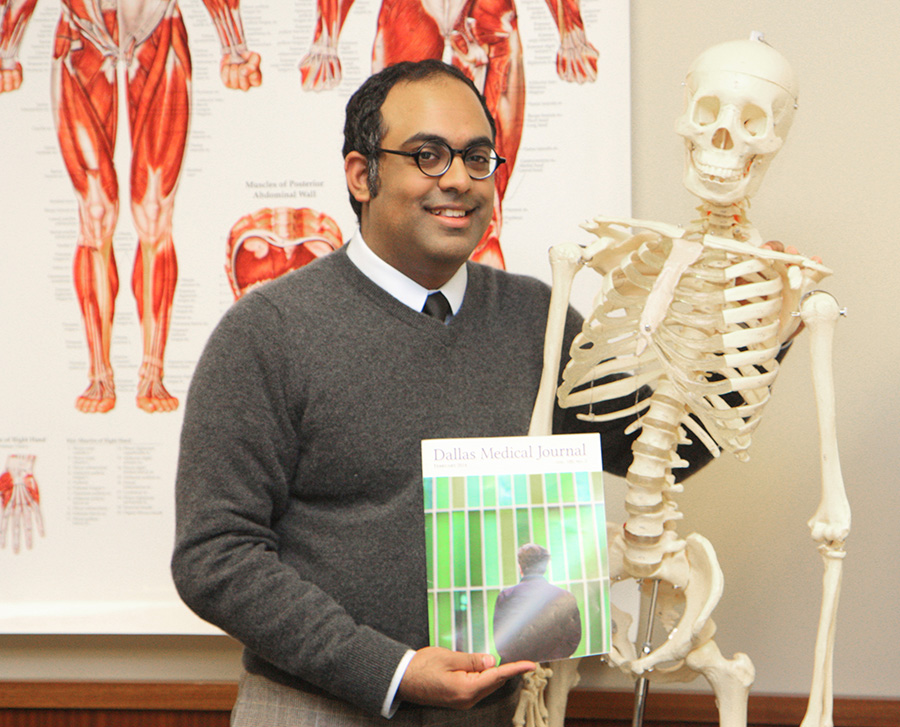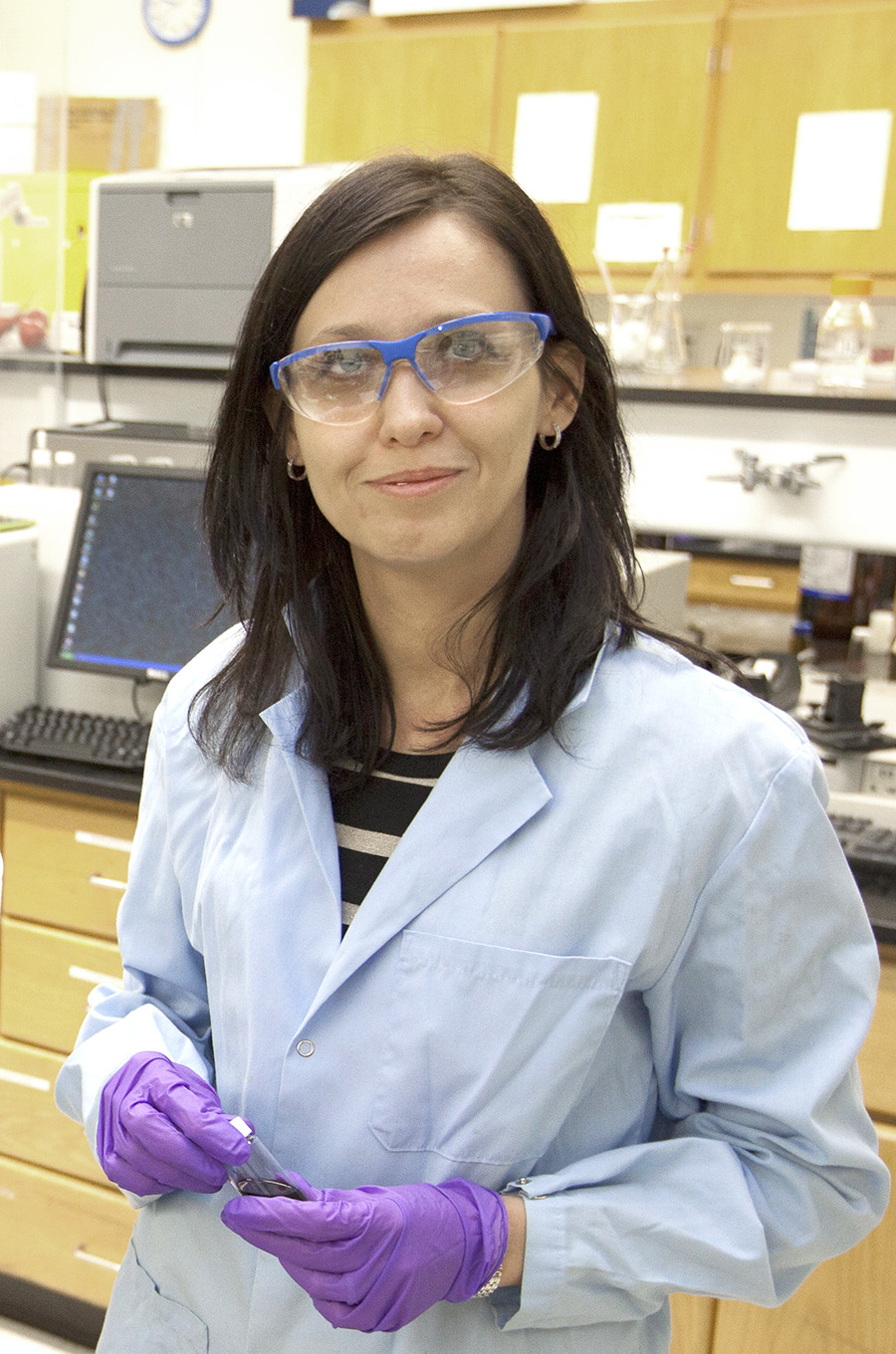
Chris Sebastian is completing his post-baccalaureate work in biology and health care studies before attending medical school at Texas A&M in the fall. Previously, Sebastian earned a graphic design degree and redesigned the Dallas Medical Journal, which he holds above.
UT Dallas post-baccalaureate student Chris Sebastian has no regrets about taking the “scenic route” to medical school.
Though he began his academic career with a creative flair, earning a degree in graphic design at the University of Notre Dame in 2007, he always maintained an interest in science as well.
Sebastian kept up that interest working summers as a camp counselor for children diagnosed with Type 1 diabetes. At Camp Sweeney in Gainesville, Texas, Sebastian helped children adjust to a daily routine that included insulin injections, pump site changes, blood-sugar tests and a new diet plan.
“I fell in love with the place and teaching kids about diabetes,” Sebastian said. “It made me think that I would someday work with patients and their families.”
By summer 2011, Sebastian decided that he would pursue a medical career. Too late to register for UT Dallas classes that fall, he began tackling his science prerequisites at Eastfield College in Mesquite, then transferred to UT Dallas in January 2012 to complete his post-baccalaureate work in biology and health care studies.
“It’s an exciting time to go into medicine because there is a lot of interdisciplinary collaboration going on. I’m excited to see what’s next.”
Chris Sebastian,
post-baccalaureate student
Sebastian will begin medical school this fall at Texas A&M University, and plans to specialize in primary care or pediatrics.
“I’m 29. I could be finishing a residency program now, but I took the scenic route into med school. And I think I’ve learned a lot more than I would have if I’d gone the usual route,” he said.
For one thing, Sebastian wants to see how a design approach to problem-solving can deliver innovative solutions to patients and health care providers, whether it’s a new design for a medical device or improving efficiency and workflow by studying the use of architectural space in hospitals.
But the biggest use for his design skills is intentional, effective communication with patients, he said.
“As a designer, I know that how you convey something is just as important as what you convey,” Sebastian said.
Dr. Karen de Olivares, director of the Health Professions Advising Center, said Sebastian may have chosen a nontraditional path to medical school, but an increasing number of universities have interdisciplinary programs that connect the humanities and medicine, including the University of Florida’s Center for Arts in Medicine.
“Chris’ path to medical school exemplifies how a person can integrate seemingly disparate areas of interest, fostering richer understandings for the benefit of others,” de Olivares said.

Dr. Mihaela Stefan, associate professor of chemistry
Dr. Mihaela Stefan, associate professor of chemistry, said Sebastian has brought his design background into the classroom to help fellow students master organic chemistry concepts. As a teaching assistant at UT Dallas, Sebastian often illustrated chemical elements to help students better understand and memorize them.
“Chris was the best student in the organic chemistry course I taught in the fall of 2012. He has never missed a lecture or a recitation, and he made an almost perfect score in my class, which is an outstanding achievement,” Stefan said. “I have no doubt that his dedication, intelligence and hard work are going to be great ingredients for a successful medical career.”
Sebastian has taken every opportunity at UT Dallas to learn about the medical field, even serving as communications officer and later president of the Post-Baccalaureate Pre-Health Society.
Though he is leaning toward pediatrics as a specialty, Sebastian has rounded out his experience by working as a hospice volunteer for the last year and a half. He said the experience with end-of-life issues has helped him learn to listen to patients and their families to see what they want, not just what’s medically possible.
“It really brings the spotlight to the patient, which is where it should be,” Sebastian said.
Meanwhile, he has also kept up his design skills. When editors at the Dallas Medical Journal saw his portfolio online, they offered him a “dream job” of redesigning the magazine. The monthly magazine is the official publication of the Dallas County Medical Society with a subscription base of more than 4,500 member physicians.
“I polished and unified it, gave it a more defined grid and simplified it. I am going to add illustrations this summer,” Sebastian said.
For Sebastian, his creativity never stops flowing.
He connects on Twitter with medical students and physicians who are interested in the integration of design and medicine and has participated in online discussions hosted by institutions such as Stanford University and the Mayo Clinic’s Center for Innovation.
Before he even lands in College Station, Sebastian has already pursued starting a new student organization at Texas A&M to explore areas for innovation in medicine and health care.
“It’s an exciting time to go into medicine because there is a lot of interdisciplinary collaboration going on. I’m excited to see what’s next.”